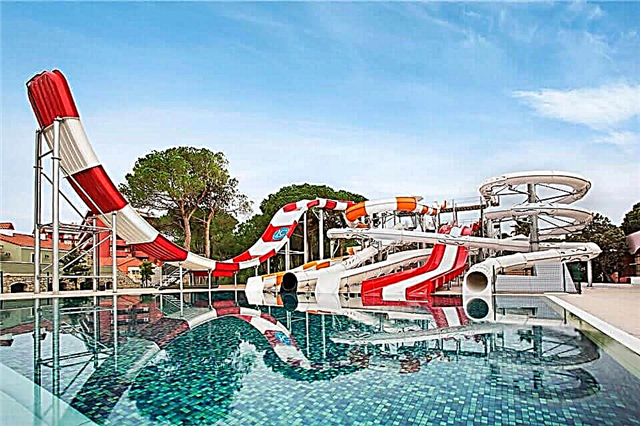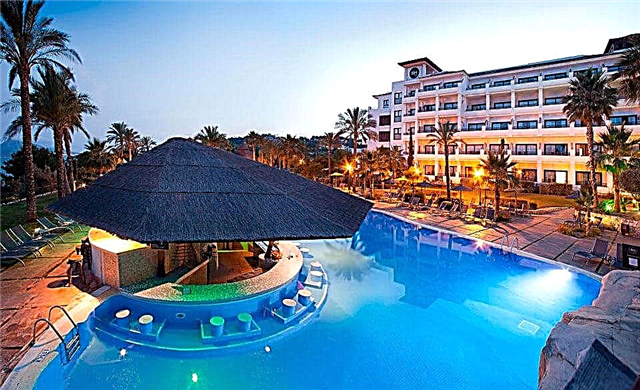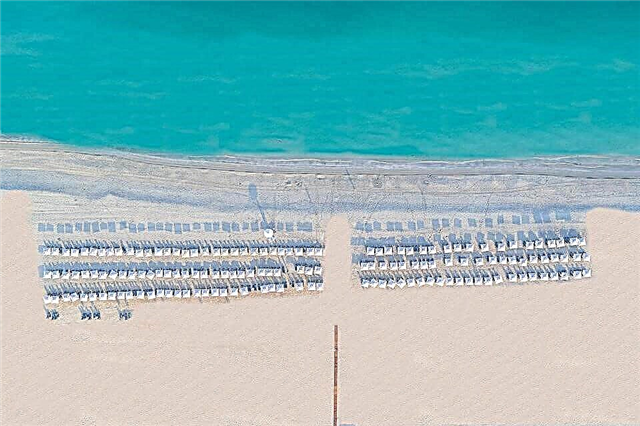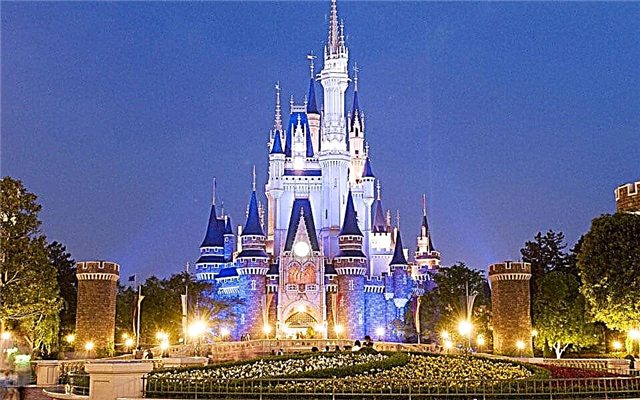Address: Russia, Moscow Kremlin
Main attractions: Cathedral of the Assumption, Cathedral of the Annunciation, Church of the Deposition of the Robe, Cathedral of the Archangel, Ivan the Great Bell Tower, Patriarchal Palace and Cathedral of the Twelve Apostles
Coordinates: 55 ° 45'02.1 "N 37 ° 37'03.4" E
Content:
The spacious Cathedral Square can be considered the main one in Moscow. There are three ancient cathedrals on it, the majestic church-bell tower "Ivan the Great", the Church of the Position of the Robe of the Mother of God and old chambers. These architectural monuments have witnessed many dramatic pages in the history of Russia. Here rulers were elevated to the kingdom, patriarchs were buried and the main royal decrees were announced. Cathedral Square has stood for over 500 years and still continues to amaze everyone who has visited the Kremlin.

Cathedral Square from the Ivan the Great Bell Tower. From left to right: Cathedral of the Archangel, Cathedral of the Annunciation, Palace of Facets, Verkhospassky Cathedral, Church of the Deposition of the Robe, Cathedral of the Assumption
History of the ancient square
Cathedral Square has the status of one of the most ancient squares in the city. The composition and the outlines of its future development were laid in the XIII-XIV centuries, when only wooden buildings existed in the Kremlin. The square appeared on the most elevated part of the hill and became the place where the main temples of the nascent state were built.
Stone buildings on the square were built gradually, and architects from Moscow, Vladimir and Pskov took part in their construction. Italians also worked here, so the appearance of most buildings was strongly influenced by the architecture of the European Renaissance. By the beginning of the 16th century, three large cathedrals, the building of the Faceted Chamber and a high bell tower, from which one could view almost all of Moscow, towered on the square.

View of the square from the Patriarchal Palace and the Cathedral of the Twelve Apostles. From left to right: Cathedral of the Archangel, Cathedral of the Annunciation, Cathedral of the Assumption
For several centuries, Cathedral Square has been the site of major celebrations and ceremonies. Here the great dukes and Russian tsars were married to the kingdom, as well as baptized the heirs to the throne. The chambers received foreign ambassadors and held zemstvo councils. In the ancient Archangel Cathedral, princes, kings and members of their families were buried, and in the neighboring Assumption Cathedral, the metropolitans and patriarchs found their last refuge.
In 1812, when the French took Moscow, the square in the Kremlin suffered from fires. The bell tower, the Filaretovskaya annex and the belfry were especially severely damaged. When the war with the French was over, the old buildings were restored.

The square in front of the Church of the Deposition of the Robe, the Assumption Cathedral and the Patriarchal Palace and the Cathedral of the Twelve Apostles.
The ancient square was reconstructed several times. In the 18th-19th centuries, its fragments were covered with stone slabs. The entire area was completely paved for the 300th anniversary of the celebration of the Romanov dynasty, in 1913. In the 1930s, Cathedral Square was asphalted. However, the asphalt pavement quickly deteriorated and looked extremely poor next to the ancient cathedrals. Therefore, in 1955 it was removed, and the old square was again paved with stone.
Cathedral Square is not the only one on the territory of the Kremlin. In addition to it, there are other historical squares behind the battlements. The famous Red Square is located in front of the Spasskaya Tower. It hosts military parades, state celebrations and large festivals. Behind the building of the Ivan the Great Bell Tower is the spacious Ivanovskaya Square, which in former times was called Tsarskaya Square. In addition, there are two more squares inside the Kremlin walls - Senatskaya and Dvortsovaya, but they are closed for tourists.

View of the Ivan the Great Bell Tower from the Annunciation Cathedral
What can be seen in the square
On a clear day, the domes of ancient churches covered with gold shine on Cathedral Square. The very first to appear on it was the Assumption Cathedral. The wooden church dedicated to the Assumption of the Mother of God has stood here since ancient times, and the first stone cathedral was erected in the 13th century. When the country was ruled by Ivan Kalita, the temple was rebuilt (1326-1327). The cathedral, which has survived to this day, was erected in the 1470s by the project of the famous Italian architect and engineer Ridolfo Aristotle Fioravanti. Until 1917, it had the status of the main cathedral in Russia.
For centuries, one of the Orthodox shrines, the Vladimir Icon of the Mother of God, was kept inside this church. Today the famous image is on display at the Tretyakov Gallery. In the cathedral, you can see 19 tombs where church hierarchs are buried. On some days, with the blessing of the Patriarch, services are held in the church.

View of the Archangel Cathedral from the Faceted Chamber
The Assumption Cathedral set the compositional basis for the entire square, and other buildings were built on it, focusing on the architecture of this five-headed giant. In the 1480s, architects invited from Pskov erected another cathedral next to the Assumption Cathedral - the Annunciation. Experts are sure that they did not build it from scratch. From the end of the 13th century in the Kremlin there was a wooden Church of the Annunciation, which the Moscow tsars used as a house church. In the middle of the 16th century, the three-domed Cathedral of the Annunciation was made nine-domed, and from this it acquired a very festive look.
Today, inside the Annunciation Cathedral, you can see frescoes and icons made by famous Russian iconographers - Theophanes the Greek and Andrei Rublev. It is curious that the images of Aristotle, Plutarch, Ptolemy, Homer and other famous Greeks are placed on the porch of the cathedral. The main attractions of the temple are the inlaid floor with bright splashes of jasper and agate, as well as luxurious wrought-iron lamps. In addition, the cathedral houses expositions of an interesting museum of treasures and antiquities.

View of the Annunciation Cathedral from the Ivan the Great Bell Tower
Opposite the Annunciation, the majestic Archangel Cathedral rises. A wooden church dedicated to Archangel Michael has existed on the Kremlin hill since the middle of the 13th century. The cathedral, which can be seen today, was built at the beginning of the 16th century. The author of his project was the famous Italian architect Aleviz Novy. In the building of the Archangel Cathedral, like nowhere else in the Kremlin, the traditions of the Italian Renaissance are embodied.
In the main grand-ducal cathedral there are 54 tombs, where the Rurikovichs and Romanovs from Ivan Kalita to the father of Peter I - Tsar Alexei Mikhailovich are buried. The walls of the old church are decorated with skillful painting. And on the large iconostasis there are many images painted under the guidance of one of the best masters of the Armory Chamber - Fyodor Zubov.
Metropolitans and patriarchs also had their own home church. This is the Church of the Deposition of the Robe, built in the 1480s. In the 17th century, the temple was connected by passages with the princely chambers and was completely rebuilt. Today, the Church of the Deposition of the Robe hosts a permanent exhibition of ancient wooden sculptures.

View of the Faceted Chamber from the Annunciation Cathedral
Ivan the Great Bell Tower rises on the border of Ivanovskaya Square. Its architectural ensemble consists of three buildings - the bell tower itself, the Filaretovskaya extension and the Assumption belfry. There are 21 bells and a museum that tells about the history of Kremlin architecture.
On Cathedral Square there are also civil buildings - the Patriarch's Palace and the building of the Faceted Chamber. The Patriarchal Palace has been used as a museum since 1918. Today, you can see rich collections of old sewing, forged items, jewelry, items from the patriarchal and royal treasury, and fragments of wall paintings from the 17th century.
For a long time, the Faceted Chamber could only be viewed from the outside. But since 2012, after the restoration, it was opened for excursions.It exhibits furniture, parquet flooring, carpets and beautiful frescoes that are used to paint the walls and vaults of the old building. Near Cathedral Square since the 19th century, Russian cannons from the times of Peter I have been installed. The cannons were made in the late 17th - early 18th centuries and are kept today as monuments of military glory. Until 2012, these guns could be seen next to the Arsenal building.

From left to right: Verkhospassky Cathedral and the Church of the Deposition of the Robe, view from Cathedral Square
Useful information for tourists
Those wishing to get to Cathedral Square and visit the churches and museums located on it should buy tickets at the box office of the Moscow Kremlin. They are located on the territory of the Alexander Garden. There is a left-luggage office nearby, where you can leave large bags and backpacks in front of the Kremlin entrance. According to the existing rules, photography and video filming inside the Kremlin museums and churches is prohibited.
Ticket offices are open from any day, except Thursday, from 9.30 am to 4.30 pm. In summer, they are opened half an hour earlier. Tickets are sold only on the day of the visit. Tourists can buy a single ticket for all museums in Cathedral Square or take a separate ticket to visit the Ivan the Great Bell Tower.

Patriarchal Palace and Cathedral of the Twelve Apostles from the Assumption Cathedral
Museums and exhibition halls on Cathedral Square are open on any day except Thursday, from 10.00 to 17.00, and from mid-May to the end of September from 9.30 to 18.00. Tours to the bell tower start at 10.15, 11.15, 13.00, 14.00, 15.00 and 16.00. In summer, an additional session is added for tourists at 17.00. The bell tower is closed during the winter months, and tours are weather-dependent during the off-season.
How to get there
The Lenin Library, Aleksandrovsky Sad and Borovitskaya stations of the Moscow metro lead to the territory of the Moscow Kremlin.











